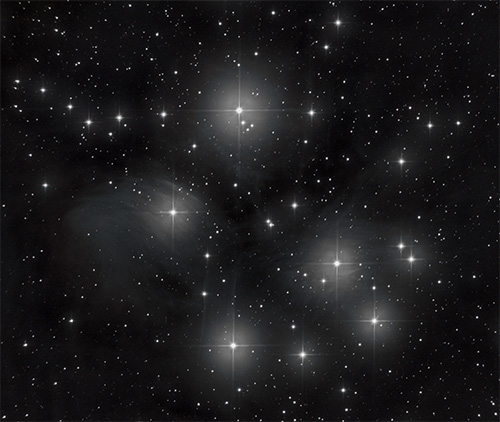
Work-in-progress of Pleiades (need more lights), but since we aren't supposed to get clear skies for a while, I decided to practice my Pixinsight on the collected data so far.
Outstanding issues that I'm working on
-
Doubled diffraction spikes? I checked, and this was present in the raw frames too, so it isn't a stacking/registration problem. I know the scope is a bit out of collimation (stars are oblong under short exposures). Likely a combination of poor focus, incorrect coma corrector spacing and collimation.
-
The blooming from the stars seems to wreck detail in the near vicinity.
-
It seems I've lost most of the color! There is very little color even if you crank up the saturation, mostly in the halos. I think my camera has a different bayer pattern than I expected, so the color was lost in debayering.
Equipment
- Orion f/4 8” Newtonian Astrograph
- Atlas EQ-G
- QHY8 OSC
- SSAG + 50mm viewfinder modified into guide scope (aka duct-taped SSAG to it)
Software
- Sequence Generator Pro
- PixInsight
- EQmod
Frames
- Bortle Zone: ~3
- Average temp: 10° - 15° F
- Lights: 18x400s
- Darks: 20x400s
- Bias: 80x0s
- Flats: 80x0.005s
Processing
- BatchPreprocess (bias + overscan, dark, flat, light + VNG debayer)
- DrizzleIntegration (x2 with 0.9 drip)
- DBE
- BackgroundNeutralization
- SCNR for green
- ColorCalibration
- TGVDenoise
- ATrousWaveletTransform to suppress a bit of “grid” pattern from drizzle (oops)
- MaskedStretch
- HDRMultiscaleTransform (6 layers to help tone down blooming)
- HDRMultiscaleTransform (2 layers for small details)
- MorphologicalTransform with star mask to reduce stars a bit
- Curves
- Final Histogram to clip blacks a bit more